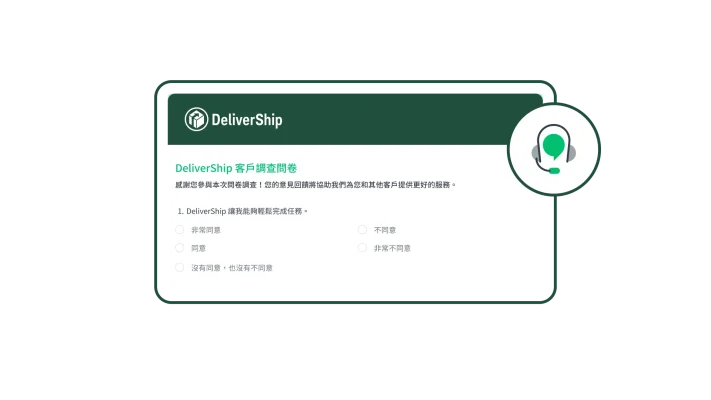您最近曾因為聽到負面評論而迴避某個品牌嗎?或是否曾因為某次失望的經驗而不再回到某家商店光顧呢?
您又有多常刻意聯繫商家,讓他們知道您選擇不再上門的原因呢?
既然您的工作是改善客戶體驗 (CX),就不能守株待兔,期待客戶主動向貴組織反應問題,而是應該提倡、執行並維持客戶心聲 (VoC) 計畫,確保您與客戶之間有暢通的對話管道。
何謂客戶心聲計畫?
客戶心聲的定義:客戶心聲計劃就是系統性地收集、分析和觀察客戶與您的產品、服務或品牌的互動狀況。
VoC 計畫對於您整體的客戶體驗 (CX) 十分重要,它的設立其實就彰顯出您有決心要以實際行動回應客戶的意見回饋。您的初始目標應該是要彌合客戶期待與組織表現之間的差距。一個持續有效運行的 VoC 計畫能夠幫助員工理解客戶的需求,並超越客戶的期望。
打造 VoC 計畫 vs. 收集客戶意見回饋
許多組織會透過調查問卷、意見回饋表單和舉辦焦點小組等方式詢問客戶的意見,但企業打造客戶心聲計畫,目的並不只是為了收集意見而已,更是為了讓客戶的參與度、忠誠度和滿意度成為企業策略的核心。有效的 VoC 計畫會包括:
- 具體的企業目標
- 領導階層的支持
- 員工的參與和合作
- 對客戶歷程的全盤瞭解
- 主動聆聽來自各個管道和接觸點的客戶心聲
- 規律的客戶和市場研究
- 資料分析和報告
- 內部溝通
最重要的是,有效的 VoC 是能化為行動的,它讓公司能夠找出痛點、解決問題,並將所做的改變傳達個員工和客戶,建構完善的客戶意見回饋迴路。
本文將教您如何從規劃、執行到維護,一步一步自己打造客戶心聲計畫,並提供建議、關鍵 VoC 指標和客戶心聲調查問卷範本等資源來幫助您上手。
打造客戶心聲計畫
1. 打造客戶心聲計畫之前,需要先獲得領導階層的認同和支持
無論是要設立新的還是改造現有的 VoC 計畫,都需要耗用時間和資源。在正式開始籌備前,建議您收集下列資訊並呈交給領導階層,確保他們都同意並支持。
- 關鍵客戶痛點或表現不佳的指標 (例如客戶流失率與去年同期相比上升 5%)。
- 說明 VoC 計畫是什麼,或您認為現有的 VoC 計畫如何可以更好。
- 分享幾個別家公司的案例研究,強調聆聽客戶意見並採取相應行動的重要性。例如美國灰狗巴士公司在對客戶體驗做出重要調整,使關鍵客戶忠誠度指標上升 15 個百分點之後,獲利能力也跟著提升。
2. 與關鍵的利益關係人合作,共同設立目標
一旦獲得領導階層的支持,您就可以開始在公司內進行跨團隊合作。由於每個利益關係人都有其獨特的思考角度,因此可以對客戶體驗改善工作做出不同的貢獻。
- 客戶成功或客戶服務部門是直接面對客戶的第一線人員,因此最瞭解關鍵痛點,也最知道貴公司的產品或服務存在哪些問題。
- 行銷和通訊部門對於競爭環境和市場環境最為瞭解,他們也可能會透過社交媒體直接與客戶溝通。
- 銷售部門最瞭解潛在客戶的價格敏感度、市面上的競爭產品和解決方案,以及公司哪些產品訊息對客戶有效果 (或沒有效果)。
- 產品團隊能夠幫助您瞭解人們與公司產品或服務的互動狀況,包括客戶流失率、錯誤率或放棄率。他們也能清楚說明公司產品的運作方式,並告訴您有哪些潛在的問題或異常可能正在影響客戶的滿意度。
- 人力資源或人力營運部門能夠指出員工體驗方面的問題。公司的員工參與度高嗎?他們覺得自己有辦法對客戶體驗帶來正面影響嗎?
這些團隊可能各自有不同的目標或成功理念,所以您可以先選擇一個全公司的共同目標 (例如讓客戶滿意度提升 10%),然後鼓勵每個團隊設定自己的目標。
要記得,這是一個以客戶為中心的計畫。產品團隊或許會覺得提升註冊率和改善新手使用體驗是首要任務,但是在客戶心聲計畫的原則之下,產品團隊和客服團隊的溝通連結可能是更重要的,因為客服團隊可以指出新手使用體驗的痛點,讓產品團隊去解決這些痛點,進而達到減少客服工單量的目標。
3. 製作客戶歷程圖
- 購買之前:廣告、口碑、社交媒體
- 購買期間:網站、商店、銷售點
- 購買之後:帳務處理、交易電子郵件、線上客戶支援中心
在製作客戶歷程圖的時候,您也應該注意您詢問客戶意見回饋的時機、地點,以及頻率,這樣能幫助您調整調查問卷,改善整體的規劃和追蹤方式。
想知道如何製作客戶歷程圖嗎?
瞭解如何製作客戶歷程圖,以整合所有利益關係人的觀點並達成業務目標。
4. 定期聆聽客戶的意見
在這裡,聆聽客戶意見是指透過客戶心聲意見回饋計畫收集結構化和非結構化 (定量和定性) 的資料。
結構化的資料是可量化、可測量的。例如,您可以用調查問卷詢問客戶再次回來向您購買的可能性有多大,由於他們會從既定的選項中選取答案,因此調查結果可被數值化,像是「76% 的人表示他們會再次購買您的商品」。
非結構化的資料則是定性而無法測量的。例如,您可以在購買體驗調查問卷中要求客戶說明他們為什麼「非常有可能」再次向您購買,並請他們將理由寫在您提供的文字方塊內。這些回覆將能讓您深入瞭解這個數字背後的原因。
若要全面瞭解您的客戶體驗,建議您同時收集這兩種類型的資料。您還可以透過下列這些不同的方式定期聆聽客戶的意見,使您的客戶心聲計畫更有效:
5. 收集關鍵的客戶心聲指標
企業要瞭解客戶體驗,可以參考幾個業界通用的 VoC 指標。以下介紹三種最被廣為的 VoC 指標:
Net Promoter Score (NPS)

如果想知道某個人將貴公司推薦給朋友或同事的可能性有多大,只要使用 Net Promoter Score® (NPS) 調查問卷就能獲得可量化、可持續追蹤的答案。以下概略說明 NPS 調查問卷的特色。
- 簡單的計算 NPS:受訪者會從 0 到 10 分選擇一個評分,而整體結果會是一個介於 -100 和 +100 之間的數值。
- 可追蹤且便利:Net Promoter Score 問題直截了當又多功能,可以用來詢問某個人是否會推薦您的品牌、應用程式或軟體。NPS 問題不需與特定活動有關聯,因此很適合用來評估貴組織在任何時候的表現。
- 實用的產業指標:由於 NPS 被許多組織廣泛使用,因此您可輕易將您的分數與同業其他公司比較。例如,在分析數百分 NPS 調查問卷後,我們發現醫療照護業的平均分數是 38。
客戶滿意度 (CSAT)

- 與 NPS 相輔相成:CSAT 和 NPS 都是很重要的 VoC 指標,能讓您從不同角度檢視客戶體驗。
- 具體且可化為行動:CSAT 調查問卷可用來針對客戶體驗的特定面向進行改善。您可以詢問客戶對客戶服務的意見回饋,或收集活動意見回饋來得知參加者的滿意度。
- 容易計算和分析:CSAT 調查問卷是以數值化量表 (如 1 到 5 分) 作為答案選項。您可以查看原始資料,如 478 名客戶表示他們對於最近一次與客服的互動感到滿意,或透過分析工具計算百分比。
客戶費力度 (CES)

6. 分析結果
在您開始從各個接觸點收集客戶意見回饋之後,接下來就必須仔細分析資料集並比較不同的調查結果了。
- 請各個部門的合作夥伴分享他們從客戶和市場研究、社交媒體頻道及其他管道獲得的深入解析。最好能把所有資訊都集中在一處,例如公司的內部維基或內部網站。
- 有些資料 (如您的 Net Promoter Score) 非常直觀,無需深入解釋也能輕易看懂,但如果是開放式問題的回覆,建議您利用文字分析工具來找到趨勢。
- 您也可以利用進階分析工具 (如自訂資料篩選條件) 對調查資料進行多維交叉分析,從調查結果中獲得更豐富而深入的客戶洞見。
7. 採取行動、維護計畫並重複執行
一旦確定了聆聽客戶心聲的策略,您就可以隨時注意指標動向,一看到 NPS 或客戶滿意度有些許下降就迅速做出反應解決問題。
從長遠來看,您需要的是建立一個框架,讓公司的 VoC 計畫能夠穩健執行。下面幾個想法供您參考。
- 影響產品路線圖:產品團隊可以設下每一季解決一至兩個客戶問題的目標。
- 改善客服的訓練及回應能力:服務團隊可以優先改善員工入職培訓和同理心訓練,或針對客戶最常提出的疑難雜症設計回應範本,節省反應時間。
- 邀請公司上下共同參與:每半年抽出一到兩個星期專門解決客戶的問題,或回應客戶的重要意見回饋。
- 將客戶置於企業的核心:定期邀請客戶來和員工分享他們的故事。
- 檢討不足之處並分享成功經驗:您可以考慮以月刊的方式分享您收集到的重要意見回饋、資料趨勢,以及能激勵員工的客戶故事。
客戶心聲計畫的優勢
您的客戶越高興,他們就越容易對您的品牌忠誠,也更願意將您推薦給別人。不過,客戶忠誠計畫還能為企業帶來其他容易被忽略的好處。
改善員工參與度
客戶心聲計畫是能幫助員工對客戶體驗做出直接貢獻的一種方法。您也可以鼓勵團隊設定以客戶為中心的目標,並且在他們達成目標時給予獎勵。
帶來競爭優勢
大部分的意見收集都是在收集回應,也就是說,您只能知道客戶與您的品牌互動後有什麼感受。完整的 VoC 計畫也包括主動蒐羅意見回饋,像是進行焦點小組、客戶面談、社群聆聽、使用者研究等等,這些對於獲得新的產品構想和解決客戶痛點等工作都有幫助。
獲得更多客戶見證和社群認可
您可以把正面的客戶回饋和互動寫成有說服力的案例故事,透過行銷傳單、網站或社交媒體等途徑將這些故事分享出去。
如何克服 VoC 計畫常見的挑戰
挑戰一:孤立的客戶意見回饋和資料
市場研究、使用者見解、客戶服務意見回饋、社交媒體互動、問卷調查結果——把這些資料拼湊起來,才能夠呈現客戶體驗的全貌。如果這些資料各自孤立於不同的平台,您就很難從中找出隱藏的趨勢,以及有利組織內部團隊採取行動的重要機會。
建議您設法讓利益關係人和團隊將他們的發現分享到一個共同的平台,例如透過可連結 Salesforce、HubSpot、MailChimp、Zendesk、Zoom 及其他工具的調查問卷整合功能,簡化收集和管理意見回饋的工作。
挑戰二:客戶不願參與問卷調查
您收到的調查問卷回覆數量不足,以至於無法獲得有統計顯著性的結果嗎?您可以考慮在客戶心聲計畫中加上「調查問卷稽核」的環節,確實核對您的調查問卷是否滿足調查問卷最佳實務檢查清單上的要點。
客戶可能會因為您的調查問卷太冗長或難以理解而忽略不回覆,所以我們建議您使用專家撰寫的調查問卷範本和客戶滿意度調查問卷問題,以確保回覆數量可靠而穩定。
如果您仍然不確定您的調查問卷為何效果不彰,歡迎參考「提升客戶滿意度調查問卷回覆率的祕訣」和「客戶滿意度調查問卷問題的撰寫最佳實務」。
挑戰三:部分團隊沒有興趣參與
光是為了讓客戶開心,可能不足以讓所有團隊卯起勁來解決客戶的問題,有時候您必須將客戶滿意度與公司收益掛勾。舉例來說,您可以用客戶終身價值和可能回購客戶的人數來約略計算提升客戶滿意度的投資報酬可能有多高。
拿出有說服力的研究結果來提升團隊的參與動力。例如我們的研究顯示,有 75% 的顧客會因為某次糟糕的產品內體驗而對一家企業失去信心。
如何打造成功的客戶心聲計畫:五個最佳實務
VoC 的設計宗旨是要掌握客戶的情緒脈動,下列最佳實務可以幫助您與客戶展開有效對話,整合所有利益關係人的目標,並推動有影響力的變革。
- 別忽略隱式資料。「隱式資料」,例如應用程式使用狀況或流失率等資料,與客戶意見回饋這類「顯式資料」不同。滿意的客戶能夠告訴您他們為什麼喜歡您的應用程式,但如果客戶不再使用您的應用程式,您反而應該問他們更多問題。
- 開始分析資料之前,應該先進行資料清理,以獲得更準確、更有行動價值的分析結果。
- 一般來說,公司員工越感到開心,客戶的體驗就會越好。建議您與人力資源或人力營運部門展開合作,追蹤員工參與度和滿意度,例如透過 eNPS 問卷調查。您還可以將重要的員工參與度指標 (如員工 NPS) 持續與客戶 NPS 分數進行比較。
- 將調查結果放在大脈絡底下解釋。長時間追蹤客戶滿意度固然很好,但您也必須將調查結果與基準比較,以看出自己在眾多競爭者當中真正的實力。
- 您的客戶心聲計畫必須跟得上時代。認真瞭解客戶體驗的趨勢變化,像是客戶體驗專家如何使用新興的 AI 工具、如何滿足消費者不斷變化的期望等等。
立即開始打造您的客戶心聲計畫
使用專家撰寫的客戶心聲調查問卷範本,只要幾分鐘就能寄出調查問卷。如果您還需要更多協助,可參考這篇文章瞭解 SurveyMonkey 能如何協助您打造更棒的 VoC 計畫。
Net Promoter、Net Promoter Score 和 NPS 是 Satmetrix Systems, Inc.、Bain & Company, Inc. 和 Fred Reichheld 的商標。
探索更多資源

適合您職位的解決方案
SurveyMonkey 可協助您更有效地完成工作。探索如何藉由制定成功策略、產品、體驗等來發揮更大影響力。

Hornblower 改善了全球客戶體驗
探索 Hornblower 如何使用 SurveyMonkey 和功能強大的 AI 來充分利用 NPS 資料、收集客戶見解並改善客戶體驗。

了解瑞安航空如何大規模收集客戶見解
了解瑞安航空如何使用 SurveyMonkey 及其 Microsoft Power BI 整合功能,每月追踪 5 萬份 CSAT 調查問卷並改善客戶體驗。

瞭解 woom 如何改善員工和客戶的體驗
探索 woom 如何使用 SurveyMonkey 建立大規模的多語言調查問卷、改善員工體驗,並收集客戶的見解。
